HD Hyundai builds Aegis destroyer with anti-ballistic missiles
The second-generation Aegis system-equipped ship is armed with ballistic missile interception capabilities
By Nov 22, 2023 (Gmt+09:00)
Hankook Tire buys $1 bn Hanon Systems stake from Hahn & Co.


NPS to hike risky asset purchases under simplified allocation system


Osstem to buy BrazilŌĆÖs No. 3 dental implant maker Implacil


UAE to invest up to $1 bn in S.Korean ventures


US multifamily market challenges create investment opportunities


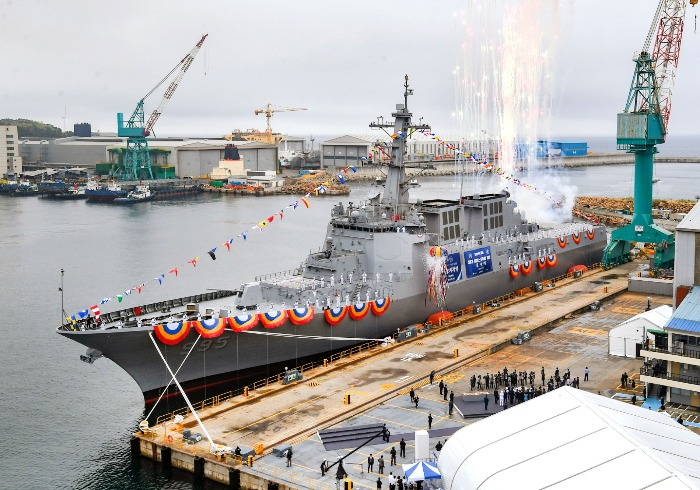
ULSAN, South Korea ŌĆō┬Ā At the shipyard of HD Hyundai Heavy Industries Co. on Nov. 20 in Ulsan, South Gyeongsang Province, South Korea's next-generation Aegis destroyer Jeongjo the Great and its frigate Chungnam were anchored at side by side at Quay 11 like brothers.┬Ā
The two warships, completed after about 60 months of construction, are in pilot operations by the South Korean Navy before their delivery to the Navy at the end of next year.
Jeongjo the Great, built with South Korea's own technology, is about 600 tons larger than the 7,600-ton Sejong the Great class, its first-generation Aegis destroyer.
What makes it notable is its ballistic missile defense capabilities. It is equipped with RaytheonŌĆÖs standard missile (SM)-6 system, which South Korea in 2022 acquired from Raytheon, a US defense company, to enhance the Aegis destroyer's missile interception capabilities.
Jeongjo the Great is 170 meters long, 21 meters wide and 50 meters high, sailing at a speed of 55 kilometers per hour.
It is composed of nine floors -- four floors underground and five floors above ground -- with 500 compartments inside. Unlike civilian ships, warships have a closed-compartment structure to block the inflow of seawater.
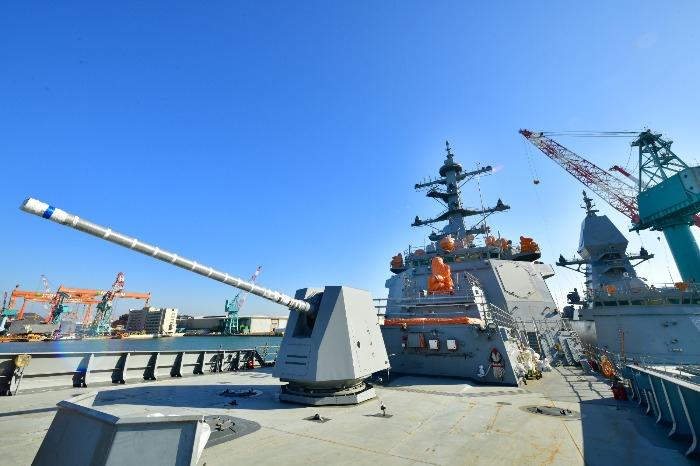
IMPROVED SURVIVABILITY
ŌĆ£Jeongjo the Great is made up of about 500 compartments like blocks, so it can enhance survivability from enemy torpedo attacks and sinking,ŌĆØ said an official from HD Hyundai Heavy Industries.
ŌĆ£The Navy expressed high satisfaction about its riding experience. It is like riding a mid-size sedan.ŌĆØ
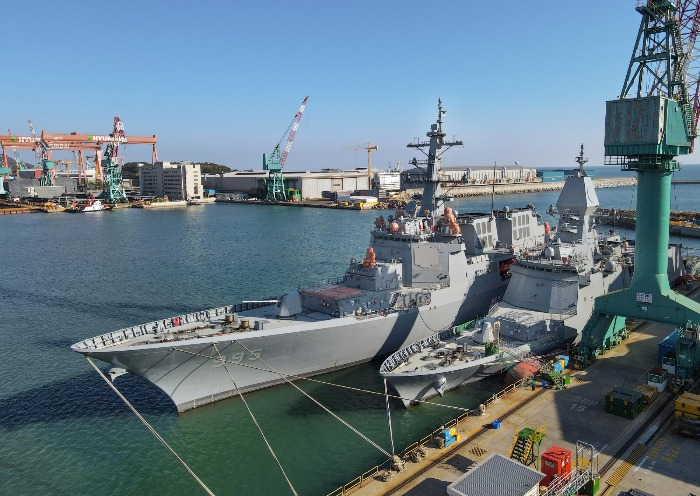
Jeongjo the Great is installed with an integrated combat system, dubbed the Aegis system, to deal with attacks from multiple submarines, fighter jets and missiles as a single battleship.
It also sharpens its defense capabilities with the advanced combat system, Aegis Baseline 9.C2.0, developed by Lockheed Martin this year, to intercept medium-range ballistic missile targets.
It is capable of detecting more than 1,800 targets at a distance of more than 1,800 kilometers with a 360-degree omnidirectional surveillance phased array radar (SPY-1D).
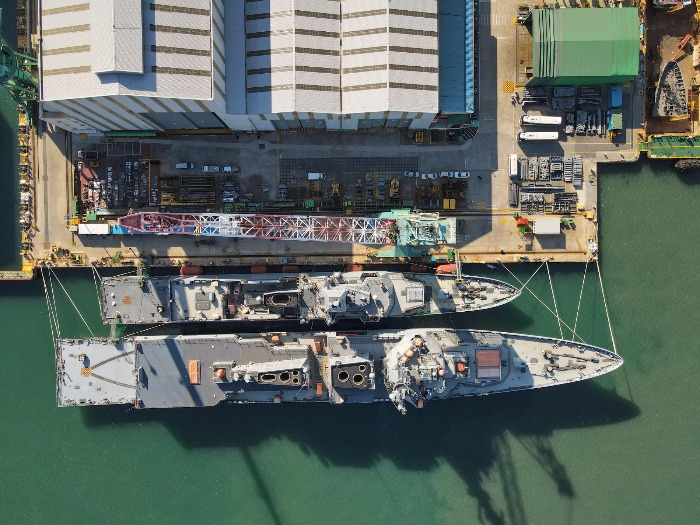
DETECTION OF UNDERWATER THREATS
In addition, it adopted a low-frequency-based sonar detection system that increases the detection distance by about 1.5 times, compared with the existing high-frequency-based sonar system.
Jeongjo the Great can operate on electricity as well, with two hybrid electric propulsion systems, which reduce noise, built on the existing four gas turbines.
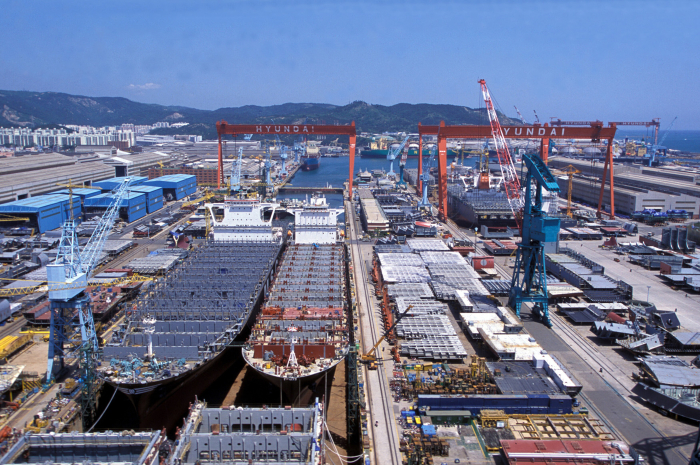
MILITARY PATROL SHIPS FOR THE PHILIPPINES
On Nov. 22, a groundbreaking ceremony was held for the construction of the first 3,200-ton Philippine patrol ship at its special ship dock in the shipyard.
The ships are scheduled for delivery to the Philippine Navy by 2025. The shipbuilder also has bagged an order for maintenance and repair (MRO) for two frigates delivered to the Philippine Navy between 2020 and 2021.
ŌĆ£We plan to double sales volume from special ships to achieve the economies of scale so that our special ship business can be competitive enough to stand alone,ŌĆØ Joo Won-ho, head of HD Hyundai HeavyŌĆÖs naval and special ship business unit, told reporters.
ŌĆ£We are looking to acquire shipyards in other countries, including Southeast Asia and South America, and also preparing to establish overseas subsidiaries.ŌĆØ
Write to Mi-Sun Kang at misunny@hankyung.com
┬Ā
Yeonhee Kim edited this article.┬Ā
-
 Shipping & ShipbuildingS.Korean HD Hyundai inks $3.9 bn Qatar LNG tanker deal
Shipping & ShipbuildingS.Korean HD Hyundai inks $3.9 bn Qatar LNG tanker dealOct 25, 2023 (Gmt+09:00)
4 Min read -
 Aerospace & DefenseHD Hyundai Heavy Industries starts building next-gen Aegis-equipped ship
Aerospace & DefenseHD Hyundai Heavy Industries starts building next-gen Aegis-equipped shipJul 04, 2023 (Gmt+09:00)
2 Min read -
 Aerospace & DefenseHD Hyundai Heavy Industries launches new frigate Chungnam
Aerospace & DefenseHD Hyundai Heavy Industries launches new frigate ChungnamApr 10, 2023 (Gmt+09:00)
1 Min read


